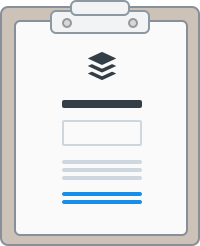Weekly active Awesome + Individual plan users
164,945 -1.8%
Weekly active
Buffer for Business users
4,887 -1.1%
Buffer for Business
Monthly Recurring Revenue
$509,313 +1.8%
Social updates sent by
Buffer for Business
users
3,815,321 +15%
Users starting
Buffer for Business
trials
4,638 -25%
Converted
Buffer for Business
trials
272 -29%
Individual + Awesome update: Instagram Improvements include Grid, Past & Repeat Reminders
Update by Suprasanna Mishra
Instagram grid preview prototype in the works
We’re continuing our work on Instagram grid preview, the ability to preview what your grid will look like with all your pre-scheduled posts. This was something we found many social media marketers are very conscious of! In October, we started exploring this concept and doing a lot of research to figure out what customers were really looking to get out of a feature like this.
Through November, we took these learnings and started working through a few potential directions for the first version; picked one of them and are currently working through building it out as a prototype! Once we have that ready and tested, we’ll build it out fully for customers and test it with a beta group. We’re excited to see what everyone thinks about this, more to come on this as we get it closer to reality!
Did you miss that first Instagram Reminder? Not to worry!
We’ve also been spending a lot of time learning from customers how Instagram Reminders fits into their workdays. With so many things going on during the typical workday, it’s easy to miss a notification that it’s time to post to Instagram!
To help with this, we’re testing a prototype with some customers that sends repeat reminders if you happen to have missed the first one.
Here’s how it works: You set up an Instagram Reminder schedule. Let’s say you have 5 per day and one of them is set at 1 pm. When 1 pm rolls around, you get your Buffer Instagram Reminder just as it works today. However, with this prototype version, if you don’t open the reminder to post to Instagram, we’ll send you a gentle nudge with another reminder 20 minutes later and then 40 minutes later.
We’re currently collecting feedback from our beta group on this to see if this is helpful and how often they find themselves using the repeat reminders to post to Instagram!
Which ones did you forget to post, again?
A third area where we’re focusing on with Instagram is improving the experience of using “Past Reminders.”
We’ve now heard lots of feedback from customers that Past Reminders is helpful for finding an Instagram image you forgot to post but it was tough to sift through a long list to get to the one you wanted.
We’re currently mocking up how that section could be improved to show just the Reminders we think you might’ve missed rather than just showing you a big, long list. We hope to build out this prototype and test it with customers in December to get some feedback on how it feels!
Polishing up the web Composer experience
In November, we worked to get all the major pieces ready for our new composer experience in the Buffer extension! We’ve been continuously testing the new experience with our beta group, and members have been so generous with their time and feedback to help us get it feeling great.
We made dozens of changes and improvements in November. We wanted to make sure we kept all the features customers were used to seeing in the current experience and also address bugs we found during beta testing.
Highlights included creating new user interface elements to help guide customers through any errors; fixing visual styling in the new composer to match our new, updated style guide; and adding in drag and drop support for images to upload with your posts.
We’re spending December getting the details right and looking toward a slow expansion of the beta group in preparation for a general rollout early next year!
Buffer for Business update: Final stages for business plan updates
Update by Tom Redman
Organization Admin tool launched!
Our new team member and social profile management tool is now available to all Buffer for Business users!
This tool provides an intuitive, streamlined way to manage your team, their posting permissions, and your social accounts in one cohesive interface.
And we’re continuing to develop this tool, with the addition of bulk permissions under way right now. If you haven’t already made the switch, visit your Buffer Teams page and follow the steps!
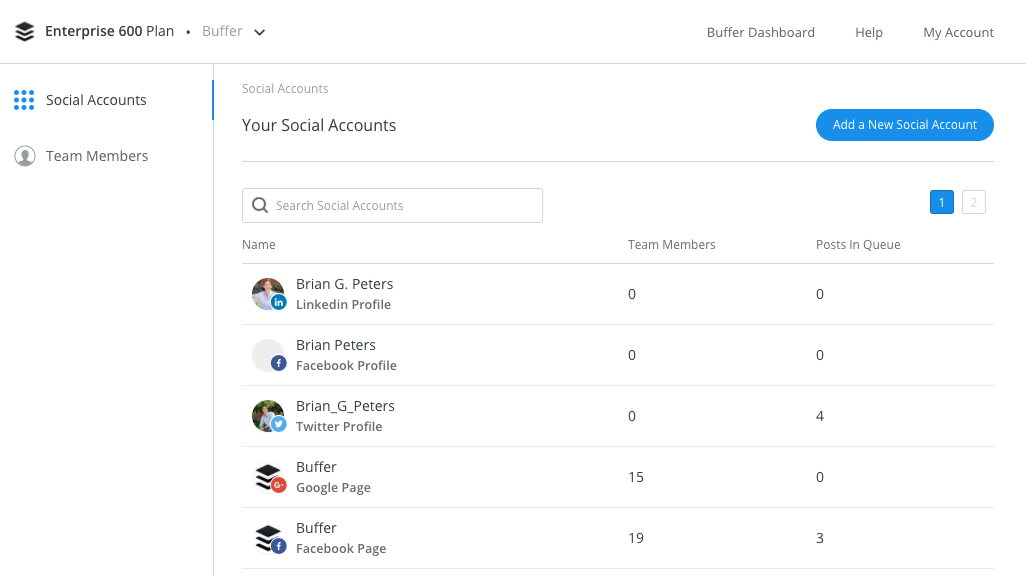
The new management tool for organizations
Re-designed, re-configured Twitter Analytics coming very soon!
Our brand new, completely overhauled Twitter Analytics are super close to completion. Our goals with these new analytics are to provide users with the most useful data possible for themselves and for their stakeholders, with the ability to export beautiful graphics to include in reports.
Here’s a (non-final) sneak peak:
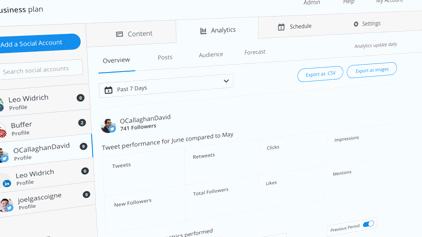
How you collaborate with your team may change soon
The new Collaboration Tool is moving along well. If you’ll recall from October’s report, this phase of the tool is designed to allow both team mangers and contributors to create and edit drafts before they’re submitted for approval by a manager.
The first phase is well under way and with most of the foundational work complete, we’re now focused on building out the front-end (the part that you’ll interact with).
Also on the horizon: Facebook Page tagging
Facebook Page tagging is also something we’ve been working on. The backend systems to support this are now built and we’re working on integrating that with our new, multiple-composers feature.
Growth update: The latest in onboarding and trial experiments
Update by Maxime Berthelot and Tom Dunn
Awesome plan benefitting from 7-day trial
Turns out, offering a trial for our Awesome plan has had some spectacular results. A nearly 650% increase in trial starts, in fact!
We shared last month how we’re now offering a 7-day awesome trial to new users. As a result, we had 33,868 customers starting an Awesome trial in November (compared to 4,557 in October – an increase of + 643%).
We’re even more blown away by how this spike in trial starts has led to an increase of 1,180 trials converting to paying customers. That’s a 60% growth rate!
We’ll continue to watch these results and report more in future months.
End of year leads to slower growth in business plans
In November we’ve seen a steady decline in new monthly recurring revenue (MRR). While we anticipate a seasonal dip in growth towards the end of the year, this decrease is coming mainly from the business plans.
We’ve seen a 25% decrease in trial starts with only 4,638 new business trials in total. As a result, we had 272 trials conversion, which is –29% less than October.
This is an important drop-off and a priority for us to understand.
Over the past couple of weeks we’ve found some bugs that made it nearly impossible for a new user to jump from an Awesome trial to a Business one, which we don’t feel great about.
We’ve since fixed this and we are now rigorously testing every flow to ensure that things like this don’t happen again. We’re taking this signal very strongly and will update you next month on our progress.
We are also removing the onboarding flow and all unnecessary modals to ensure a smooth journey for our new trialists.
Onboarding experiment aims to activate more users
We have been very excited to run a new experiment that guides newly signed-up users through a “How to Use Buffer” tour when they reach the dashboard for the first time.
Why did we run this experiment?
- Our data has shown us that roughly 75% of new signups don’t activate, with activation equalling three updates on the first day.
- Our current onboarding flow makes no impact on activation (which gives us the confidence to try something new!)
- During onboarding, we asked new signups what they planned to achieve in their first session: 30 percent stated that they wanted to figure out how Buffer works in their first session.
- We observed a common pattern of new signups appearing lost and confused in the dashboard for the first time using Hotjar. These users spent a fair bit of time trying to figure out where to schedule posts and where to edit and set up their schedule.
These learnings and signals have given us confidence to approach onboarding from a slightly different angle.
Our current onboarding flow focuses on getting people set up before reaching the dashboard, whereas this version focuses on the dashboard itself and outlines key steps required to successfully publish a first post.
What did this new experience look like for signups users ?
For this experiment, new users were led straight to the dashboard tour once they signed up.
The tour begun when at least 1 profile was connected, and we identified 3 key steps for the user to take:
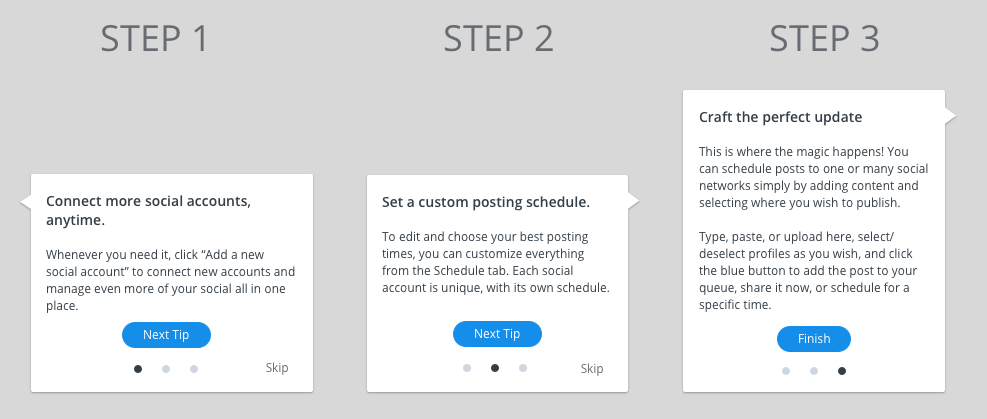
Quick learnings and a drastic adjustment
We pushed this experiment experiment live for only 24 hours, despite planning to deploy it for at least one week.
Right away, we started to observe a common pattern of users being annoyed by the number of modals showing up after signups. The flow was failing our users. We ended the experiment and will keep experimenting with a new flow.
Refunds for the failed pricing experiment
Since last month, we’ve processed most of the Awesome plan pricing refunds — we experimented with doubling the price of our Awesome plan and found that it resulted in less overall revenue. We have since decided to stick with our original $10 a month pricing and are issuing refunds for the customers we charged $20 a month as part of the experiment.
So far, we have refunded 329 customers for a total of $10,522.
We had some lovely responses from customers that we refunded and messages like this really emphasize the impact that pricing experiments can make for small businesses. It also validates how important it is for us to do the right thing.


Bridging the gap between product managers and customers
Over the last few weeks our product research team has been working even more closely with our product managers and designers to help them learn directly from the people who use Buffer every day.
Previously, researchers would often conduct most of the calls themselves and then share the learnings with the rest of the team through video chat and Paper docs like this one:
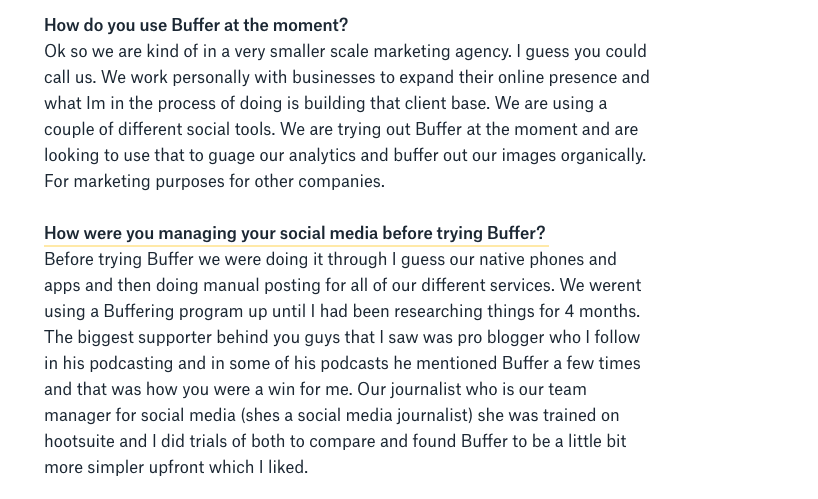
What we found was that this wasn’t as engaging or exciting as hearing directly from the people using Buffer. In addition, even the most thorough notes tended to be missing some information or emotion that could be useful in understanding feedback and bringing it on board with our decisions.
We’ve seen some really encouraging results as we’ve started to make it easier for anyone on the team to join in conversations with customers. Product managers at Buffer have always talked with customers, though these conversations were typically separate from specific product research we were conducting.
Our goal is to narrow the gap between the decisions we make building Buffer and the feedback and experiences of customers by making it easy for product managers and designers to conduct interviews with customers themselves, rather than going through an intermediate step of reading a document.
Cindy Alvarez lays out some great benefits of having team members involved in interviews, both listening and conducting the interviews themselves. Having more than one person on a call also gives us the chance to involve multiple perspectives and have really great discussions afterward about what we learned, how we could improve, and what questions to ask next.
Over to you
Is there anything you’d love to learn more about? Anything we could share more of? We’d love to hear from you in the comments!
Check out more reports from November 2016:
Try Buffer for free
190,000+ creators, small businesses, and marketers use Buffer to grow their audiences every month.
